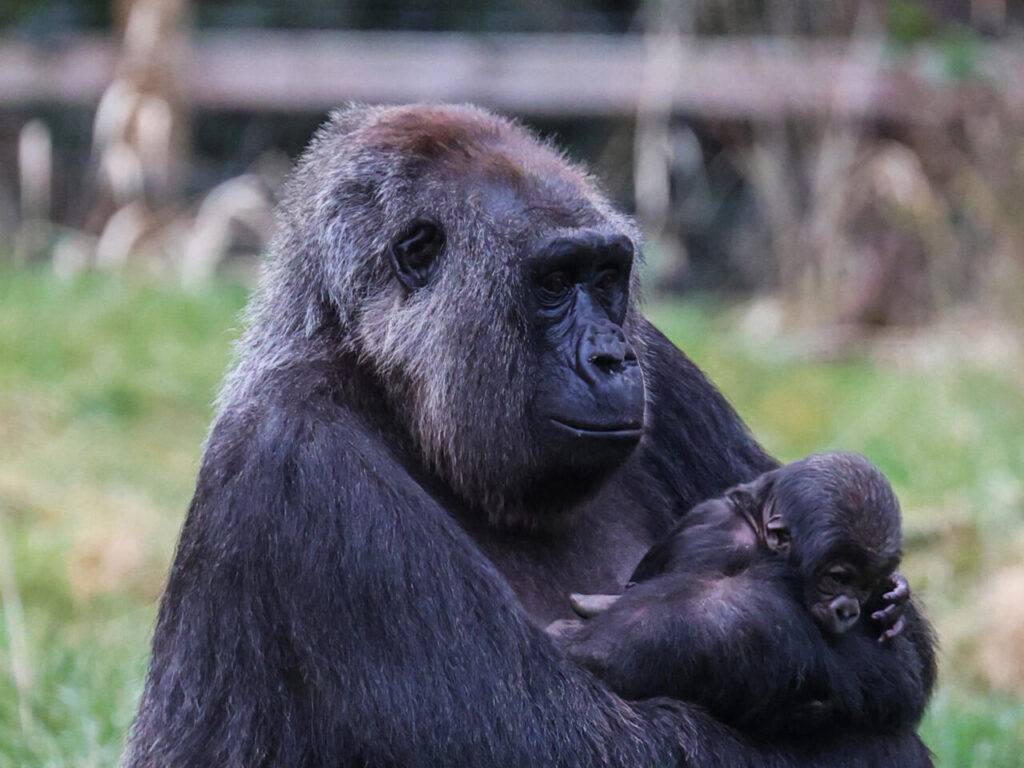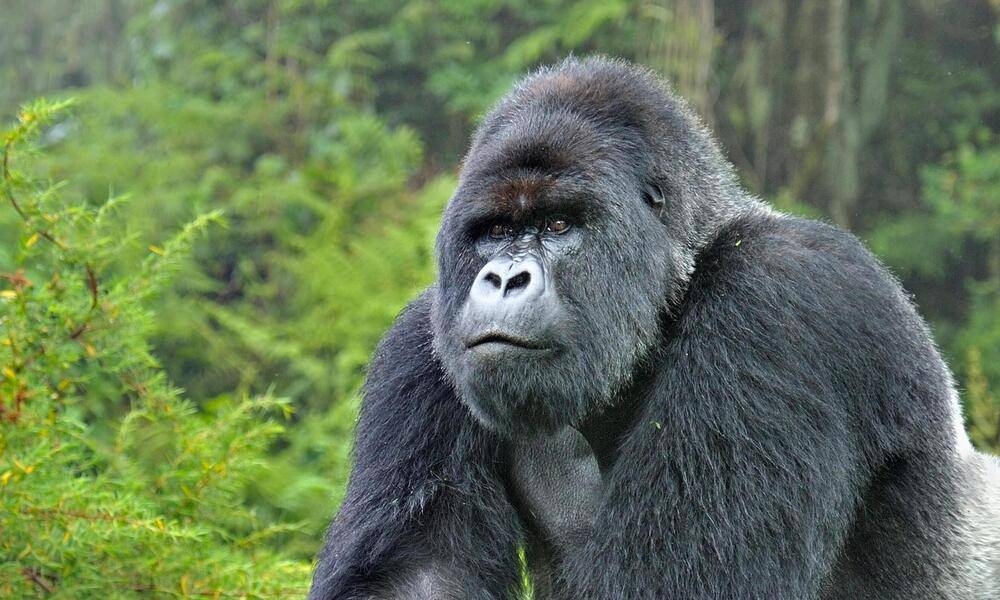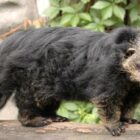Why is the newborn gorilla at London Zoo a good news?

London Zoo announced the birth of a critically endangered western lowland gorilla, marking the second arrival of the species at the facility within a month.
Western lowland gorillas, residents of dense and mostly secluded rainforests in west and central Africa, face a high risk of extinction. Their numbers have plummeted by over 60 percent in the past 25 years, primarily due to deforestation, poaching, and disease, according to the Zoological Society of London.
Kathryn Sanders, London Zoo’s primates section manager, expressed joy at the arrival, stating, “We’re thrilled to witness the birth of a second gorilla infant at London Zoo within such a short span. These additions are not only significant for the conservation breeding program of this endangered species but also vital members of our troop.
The newborn, whose gender remains undisclosed, entered the world on February 8 under the care of mother Effie, in the gym area of Gorilla Kingdom. This birth follows just three and a half weeks after another gorilla named Mjukuu welcomed her own infant.
Giant of the forest
The western lowland gorilla, scientifically known as Gorilla gorilla gorilla, represents one of the two Critically Endangered subspecies within the western gorilla species (Gorilla gorilla). These majestic creatures inhabit montane, primary and secondary forests, as well as lowland swamplands across central Africa. As the nominate subspecies of the western gorilla, they also stand as the smallest among the four gorilla subspecies.
Despite being the most diminutive subspecies, the western lowland gorilla boasts remarkable size and strength. Notably, sexual dimorphism is prominent within this species. These gorillas feature jet black skin and coarse black hair covering their entire bodies, except for their faces, ears, hands, and feet.
The hair on the backs and rumps of males turns grey with age, hence earning them the moniker “silverbacks”. Their large hands, equipped with nails on all digits akin to humans, boast formidable thumbs. Additionally, they possess short muzzles, prominent brow ridges, large nostrils, and relatively small eyes and ears. Noteworthy anatomical features include robust muscles in the jaw area, alongside broad and sturdy teeth, including frontal canines and large molars for grinding fruits and vegetables.
When standing erect, males can reach heights of up to 1.8 meters (5 feet 11 inches) and weigh up to 270 kilograms (600 pounds). On average, males weigh around 140 kilograms (310 pounds), while females typically weigh about 90 kilograms (200 pounds). In captivity, males have been observed to attain weights of up to 275 kilograms (606 pounds). Males stand upright at approximately 1.67 meters (5 feet 6 inches), whereas females stand at about 1.5 meters (4 feet 11 inches).
Although zoo owner John Aspinall claimed that a prime silverback gorilla possesses the physical strength of seven or eight Olympic weightlifters, this assertion remains unverified.
Western gorillas often stand upright but move in a hunched, quadrupedal manner, with their hands curled and knuckles touching the ground. This mode of locomotion necessitates long arms; indeed, the arm span of western gorillas exceeds their standing height.

Sociality in Western lowland gorillas
Within their territory, gorilla groups tend to gravitate towards particular areas, influenced by seasonal changes in fruit availability and the presence of open clearings such as swamps or “bais”. Typically, gorillas cover distances of 3 to 5 km (1.9 to 3.1 mi) per day, with larger groups traveling further distances to meet their dietary needs, especially if they rely on high-energy foods that vary in availability.
Males have more freedom to travel and interact between groups, as they typically leave their birth group before reaching sexual maturity, entering a phase known as the “bachelor stage“. During this time, males may roam solitarily or join nonbreeding groups for several years.
Conversely, females remain within breeding groups throughout their lives, forming strong bonds with both male and female members.
Breeding groups typically consist of one silverback male, three adult females, and their offspring. The male silverback assumes the role of protector, while females primarily bond with other females within their natal group.
Western lowland gorillas live in relatively small family units, typically comprising four to eight members. The silverback, or alpha male, leads the group in various activities such as foraging, nesting, and traveling within their territory.
Challenges to the alpha male’s authority are met with impressive displays of strength, including standing upright, throwing objects, aggressive charges, and vocalizations. Despite their intimidating size and behavior when threatened, gorillas are generally peaceful creatures. Young gorillas, similar to human children, spend much of their time playing, climbing trees, and interacting with each other.
Female gorillas have a slow reproductive rate, reaching sexual maturity around 8 or 9 years of age. They give birth to a single offspring after a gestation period of nearly nine months. Unlike other mammals, female gorillas do not exhibit visible signs of pregnancy. Newborns are small, weighing around 4 lb (1.8 kg), but are capable of clinging to their mother’s fur immediately after birth. These infants ride on their mother’s back for the first few years of their life, remaining dependent on her care for up to five years.
Intelligence and Use of Tools
Western lowland gorillas exhibit a remarkable ability to adapt tools for specific tasks by carefully selecting branches, stripping away extraneous parts like leaves and bark, and adjusting their length to suit the task at hand. Notably, they seem to strategize the use of these tools, starting with larger sticks and gradually refining them until they perfectly fit the task, showcasing a level of sensorimotor intelligence akin to that seen in young human children.
In one instance, a gorilla was observed using a stick to measure water depth, while another gorilla at Buffalo Zoological Gardens demonstrated the innovative use of a bucket to collect water, a behavior observed for the first time in zoos. Moreover, in an experiment involving adult gorillas and buckets placed near a standing pool, some individuals successfully filled the buckets, marking a significant milestone in tool usage for drinking among gorillas in captivity.
Further research delved into the gorillas’ ability to engage in reciprocal exchanges with humans, such as offering twigs in return for desired objects like fruit or peanuts. Through these experiments, gorillas quickly learned to associate giving twigs with receiving rewards, demonstrating their capacity for learning and adaptability as errors decreased over time.
Conservation status
Zoos worldwide house 550 western lowland gorillas, with the Cincinnati Zoo being a leader in western lowland gorilla births in the United States.
In the 1980s, the gorilla population in equatorial Africa was estimated at 100,000, but later adjusted to less than half due to poaching and diseases. However, recent surveys conducted by the Wildlife Conservation Society discovered approximately 125,000 previously unreported gorillas residing in the swamp forests of Lake Télé Community Reserve and neighboring Marantaceae forests in the Republic of the Congo. Despite this, gorillas continue to face threats from Ebola, deforestation, and poaching.
In the northeastern region of the Republic of the Congo, western lowland gorillas are illegally hunted for bushmeat and captured as pets, resulting in the death of five percent of the subspecies annually. Deforestation in this area facilitates the bushmeat trade and exacerbates poaching. Commercial poaching of various species, including chimpanzees, forest elephants, and western gorillas, has increased due to expanded commercial logging and infrastructure. Efforts to conserve these species from poaching and deforestation have been implemented in the Republic of the Congo.
The survival of the western lowland gorilla is threatened by bushmeat hunting and timber harvesting in its habitat, leading to its classification as critically endangered by the IUCN.










